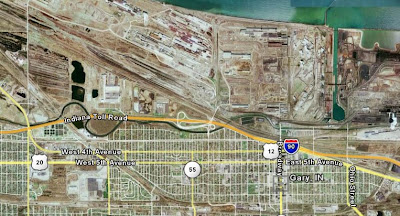 In Massachusetts, the state where Route 20 has its beginning, there is a 33-mile stretch called “Jacob’s Ladder.” It was designated a Massachusetts scenic byway in 1992, and is located between the towns of Russell and Lee, Massachusetts. It represents the perfect picturesque view of small town New England, with the backdrop of the Berkshires.
In Massachusetts, the state where Route 20 has its beginning, there is a 33-mile stretch called “Jacob’s Ladder.” It was designated a Massachusetts scenic byway in 1992, and is located between the towns of Russell and Lee, Massachusetts. It represents the perfect picturesque view of small town New England, with the backdrop of the Berkshires.The web site for National Scenic Byways describes the history of this trail:
“The Jacob's Ladder Trail originated centuries ago when people from the Mohican and Woronoake tribes walked between Connecticut and the Hudson River Valleys. The trail has now been transformed into one of the most beautiful roads in the United States. During 1910, authorities had the road built as the first highway specifically constructed for the new state-of-the-art horseless wagons, or automobiles. Adventurers from many places came to test themselves and their machines against the rugged terrain. At the time, there were potholes that could hide a tire, mud so deep it could bury a car, and small boulders blocking the road. Today, however, Jacob's Ladder Trail is a pleasant drive for motorists of a less venturesome sort. Many have appreciated the inspiring landscape of the Berkshire Hills while driving this relaxing route.
Not long after the road was built, it became known as the "Yellowstone Trail." This was because it joined with a highway that linked the Atlantic and Pacific Oceans together. The road stretched from Boston to Oregon. However, locals know this byway best as "The First of the Great Mountain Crossovers" because of the audacity and vision the engineers demonstrated by constructing this road over the wild mountains and through Jacob's Ladder Corridor.
In addition to sightseeing, visitors will find a lot of fun activities in the surrounding areas. Some of these include participating in the annual canoe race, visiting the abundant art and craft shops, or fishing some of the many lakes and streams. For those interested in the performing arts, dancers from all over the world converge at the annual Jacob's Pillow Dance Festival to put on many wonderful shows. Dancers from China, Russia, and other countries have expressed their fondness for this special community event.”
There are several web sites dedicated to this beautiful stretch of US Route 20:
Jacob’s Ladder Trail Scenic Byway This site explains what may be the history behind the name of the trail.
Jacob’s Ladder Scenic Byway
The Berkshire Web (Jacob’s Ladder Trail Page)
It sounds like a great drive in any season, rich in history and beautiful sights!
The US Route 20 Blog homepage can be found here.





